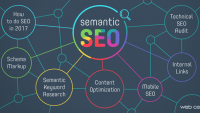Technological advances in the field of machine learning (ML) are opening up new opportunities for the Semantic Web. By combining machine learning techniques with fundamental principles related to artificial intelligence, the Semantic Web can be transformed into a smarter and more efficient platform for users.
In this article, we will explore how machine learning can be applied to the Semantic Web and what the benefits and challenges are.
What is the Semantic Web?
The Semantic Web is a concept that has gained considerable interest in recent years. It is a way to make website content more accessible by organizing and interpreting data.
This allows users to find relevant information on the web more quickly. The Semantic Web is an extension of the web itself and uses semantics to extract meaning from structural data. The Semantic Web is characterized by the implementation of a system of linked data and ontologies that can be defined as networks of relationships between different concepts, classes and properties.
These ontologies can be used to create links between specific objects or concepts, allowing for more accurate and efficient searching on the web. In addition, the Semantic Web offers developers a way to model and manage information consistently across multiple applications and services. This allows for better data sharing, searchability and visibility, which is useful for businesses looking to expand on the web.
Semantic Web technology also offers the opportunity to use machine learning to analyze web data and draw relevant conclusions. Machine learning can be applied to various fields such as finance, health, agriculture and many others.
It can also be used to extract information from existing models or to create new models from unstructured raw data. The results obtained can then be used to create more intelligent systems capable of making decisions based on the analysis of available data. The Semantic Web is an essential technology if we want to fully exploit the possibilities offered by machine learning on the web.
Indeed, it provides an ad hoc framework to organize data so that it can be used efficiently by artificial intelligence (AI) systems. Moreover, it allows AI technologies to increase their ability to take into account the specific contexts they are confronted with, thus offering greater variety and practicality to existing systems.
Finally, the Semantic Web is essential to maintain the quality of the content available on the web because it allows AI systems to perform a deep analysis of the available information and thus bring relevant content to Internet users. Thanks to the Semantic Web, developers can create more intelligent applications capable of providing users with a personalized service based on their specific needs.
What is machine learning?
Machine Learning (ML) is a branch of artificial intelligence that focuses on developing computer systems that can acquire knowledge from data and use that knowledge to solve complex problems.
In other words, ML focuses on creating algorithms that can learn from data and adapt to new conditions without being explicitly programmed. This technology has been widely used to perform complex tasks, such as medical diagnosis, automatic natural language processing and speech recognition.
Machine learning is generally divided into three main categories: supervised learning, unsupervised learning and reinforcement learning. Supervised learning uses algorithms to learn from labeled data, which means there is some sort of human teaching involved. In this case, the algorithms learn from examples provided by a human teacher and then are tested on new data to verify their accuracy.
Unsupervised learning, on the other hand, involves finding hidden patterns or relationships in the data without any human guidance. Reinforcement learning is a more advanced type of machine learning where an autonomous system learns through interaction with its environment to maximize a defined performance metric.
The applications of Machine Learning are vast and varied.
It can be applied to almost any field related to information and communication technologies (ICT).
For example, it is used to analyze marketing databases to predict future trends and improve advertising campaigns; to improve computer image understanding and visual systems; to train robots to navigate and recognize their environments; or to develop expert systems that can solve problems without human intervention.
In addition, Machine Learning is also being used to create the Semantic Web, a network interconnecting the digital information sources available on the Internet to facilitate search and access to information. Machine Learning is fundamentally different from usual data processing because it allows machines to acquire complex behaviors without being explicitly programmed.
ML algorithms can evolve according to new parameters introduced and gradually adapt to changing conditions without losing accuracy or efficiency. With its growing application in various fields such as finance, the implementation of Machine Learning offers better management and faster processing of data.
Linguistic components of the Semantic Web
The linguistic components of the Semantic Web are an integral part of its structure and operation. These components are essential to understand and exploit the potential of machine learning technologies in the context of the Semantic Web.
One of the main linguistic components of the Semantic Web is the terminology or the specific vocabulary used to describe and represent concepts, entities and relationships between different elements of a web document. Terminology is an essential tool for creating links between documents, as well as for helping to understand and interpret the information contained in a web document.

Ontologies are another important linguistic component in the Semantic Web. Ontologies are an abstract view of conceptual structure that defines the relationships between different concepts, their attributes and properties. Ontologies can be used to organize and represent information on the web, providing a common framework for representing structured data. They can also be used to provide a common vocabulary model that allows software systems to understand the structure and content of web documents.
XML is one of the primary tools used in the Semantic Web to define the structure, syntax, and metadata associated with Web documents. XML enables software systems to understand and correctly interpret the content of documents, making it possible for different computer systems to interoperate and for data to be accessed by multiple applications.
Another important linguistic component is natural language (NL), which is a set of techniques that allow computers to understand the meaning and relationships between words in a sentence or text. Natural language allows computer systems to parse and extract relevant information from raw text, allowing direct machine involvement in various processes such as sentiment analysis or named entity identification.
Speech recognition is another technique related to automatic natural language processing (NLP). It allows computers to recognize and understand human spoken language by transforming sounds into computer-understandable sentences so that they can take an appropriate action. This technology is very useful for allowing users to perform complex tasks without having to type anything on a keyboard or touch screen.
Finally, semantic markup is a commonly used method of representing knowledge on the web by assigning specific keywords to each text or HTML content that can be found on the Internet. Tags make it easier for the web browser to recognize what relevant information is on each web page, making it easier to navigate through the various documents available on the Internet. In addition, it allows software systems to more easily access relevant information by directly querying the tags associated with each individual document.
Artificial Intelligence and Semantic Web
Artificial intelligence and the semantic web are technologies that improve the way we interact with the Internet. They offer a variety of possibilities for businesses and organizations around the world and can be applied to many fields.
Their applications are varied, and their potential is considerable. The semantic web is a technology that allows computers to interpret the content of web pages to understand their meanings. It uses metadata to describe the content of web pages, allowing computers to recognize specific information such as authors, titles, dates and associated keywords. It can also be used to create links between different types of content on the Internet.
Artificial intelligence is a computer technique that allows a computer to simulate human intelligence by taking into account various data and learning by itself from past experiences. It is widely used to solve complex problems such as voice and image recognition, automated decision making or sentiment analysis.
It also enables computers to perform various tasks without human intervention, such as machine learning-based decision making or predicting future behavior. When these technologies are combined, they can provide a better understanding of web content and help computers perform more complex tasks.
This can be used to improve web search and help find answers to complex questions more easily. Possible applications include extracting relevant information from large numbers of articles or creating virtual agents that can interact with the user. Advances in machine learning have also enabled the development of the semantic web.
Machine learning is a form of artificial intelligence that allows machines to analyze large amounts of data in depth to find hidden patterns and patterns that can be useful for solving difficult problems.
This technology can be applied to the semantic web to more efficiently extract relevant information from a large number of web pages and provide better understanding of web content and provide better answers to user queries.
This study explored the possibilities and benefits of machine learning on the semantic web. The results showed that the use of machine learning on the Semantic Web can provide a variety of solutions to improve the efficiency of information systems and applications. In addition, it can improve access to information while reducing costs and process complexity. In conclusion, machine learning on the Semantic Web offers significant benefits and can be an excellent solution for many companies and organizations.
More on AI by visiting Twitter!
FAQ
What is the goal of machine learning on the Semantic Web?
The goal of Machine Learning on the Semantic Web is to develop computer systems that can interpret and analyze the data contained in the Semantic Web and improve their accuracy by learning from the examples.
What are the main advantages of machine learning on the Semantic Web?
The main benefits of machine learning on the Semantic Web are the ability to capture knowledge from complex data, the ability to reuse acquired knowledge and the improvement of system performance.






